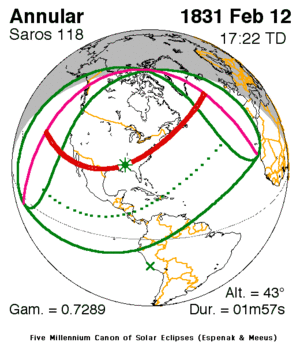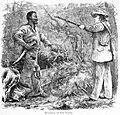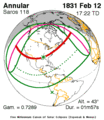Nat Turner's slave rebellion facts for kids
Quick facts for kids Nat Turner's Rebellion |
|||||||
|---|---|---|---|---|---|---|---|
| Part of the origins of the American Civil War and North American revolts of enslaved people |
|||||||
|
|||||||
| Belligerents | |||||||
| Insurgents | Local White militias | ||||||
| Commanders and leaders | |||||||
| Nat Turner |
Unknown, likely many | ||||||
| Casualties and losses | |||||||
| Approximately 160 killed or executed by militia and mobs | 55–65 killed | ||||||
Nat Turner's Rebellion, also known as the Southampton Insurrection, was a rebellion led by Nat Turner in August 1831. It involved enslaved people in Southampton County, Virginia. The rebels attacked slave owners and their families, killing between 55 and 65 people.
The rebellion was stopped within a few days. However, Nat Turner hid for over two months. After the rebellion, many white militias and mobs killed about 120 enslaved people and free African Americans in the area. The state of Virginia also executed 56 enslaved people who were accused of being part of the rebellion, including Turner. Many Black people who were not involved were also harmed.
Because Nat Turner could read and write and was a popular preacher, new laws were passed. These laws made it illegal to educate enslaved people and free Black people. They also limited the rights of free Black people to gather and worship.
Contents
Who Was Nat Turner?
|
Nat Turner
|
|
|---|---|

Discovery of Nat Turner (c. 1831–1876)
|
|
| Born | October 2, 1800 |
| Died | November 11, 1831 (aged 31) Jerusalem, Virginia, U.S.
|
| Cause of death | Execution by hanging |
| Nationality | American |
| Known for | Nat Turner's slave rebellion |
Nat Turner (born October 2, 1800 – died November 11, 1831) was an African-American preacher who was enslaved. He led a four-day rebellion of enslaved and free Black people in Southampton County, Virginia, in 1831.
Turner was born into slavery in Southampton County, Virginia. This was a rural area with more Black people than white people. He was first owned by Benjamin Turner, and later by Benjamin's son, Samuel Turner. For most of his life, he was known as "Nat." After the rebellion, he became known as "Nat Turner."
Turner learned to read and write when he was young. People noticed he was very intelligent. He was also very religious and spent a lot of time praying and reading the Bible. He often had visions that he believed were messages from God. These visions guided his life.
At age 21, he ran away from his enslaver. But after a month, he returned because he had a vision telling him to go back. In 1824, he had another vision while working for a new enslaver, Thomas Moore. He believed this vision meant that a great day of judgment was coming.
Turner often preached the Bible to other enslaved people, who called him "The Prophet." Some white people also listened to his sermons. By 1828, Turner was sure that God had chosen him for an important purpose. He believed he heard a message from God telling him to fight against evil.
In 1830, Joseph Travis bought Turner. Turner later said that Travis was a "kind master" who trusted him greatly. Turner waited for a sign from God to begin his fight. On February 12, 1831, he saw a solar eclipse. He believed this was the sign he had been waiting for. He then started to plan an uprising against the slave owners. He told four trusted friends about his plan: Henry, Hark, Nelson, and Sam.
Planning the Rebellion
Turner began to share his plans with a small group of trusted enslaved friends. These men were all from his local area. They had to find ways to talk about their plans without anyone finding out. It is thought that they might have used special songs to call fellow plotters to meet in the woods.
The Rebellion Begins
Turner believed that certain events in nature were signs for him to start the rebellion. On February 12, 1831, an annular solar eclipse could be seen in Virginia. Turner saw this as a sign that it was time to revolt. He imagined it as a Black man's hand reaching over the sun.
Turner first planned to start the rebellion on July 4, 1831. But he got sick, so he used the extra time to plan more with his friends. On August 13, the sun in Virginia looked bluish-green. This might have been from a volcano erupting far away. Turner saw this as another sign from God. He began his rebellion a week later, on August 21.
He started with a few trusted friends. Eventually, more than 70 enslaved and free Black people joined him. Some of them rode horses. The rebels went from house to house, freeing enslaved people. They also attacked and killed many of the white people they met.
The rebels mostly used knives, hatchets, axes, and other blunt tools. Guns were too hard to get without drawing attention. The rebels attacked white men, women, and children. Historian Stephen B. Oates said that Turner told his group to "kill all the white people." However, a newspaper noted that Turner said they did not plan to kill everyone once they had control. They only did it at first to cause "terror and alarm." The group spared some homes where Turner believed the poor white people "thought no better of themselves than they did of negroes." The rebels killed about 60 people before the state militia stopped them. The militia had more soldiers and artillery, which helped them defeat the rebellion.
Turner also hoped that the rebellion would show white people how cruel slavery was. He wanted to spread "terror and alarm" among white people.
After the Rebellion: Retaliation

Within a day of the rebellion being stopped, local militias and soldiers from naval ships arrived. Militias from other counties in Virginia and North Carolina also joined them. The state of Virginia later executed 56 Black people. Militias and mobs killed at least 100 more. Some estimates say 120 Black people were killed, and most of them were not involved in the rebellion.
Rumors spread quickly that the revolt was happening in other places too, even as far south as Alabama. This fear caused white people to attack Black people throughout the South for little reason. A newspaper editor described it as "the slaughter of many blacks without trial." White violence against Black people continued for two weeks after the rebellion was over. General Eppes ordered troops and white citizens to stop the killings.
A reverend wrote that "many negroes are killed every day. The exact number will never be known." One militia group reportedly killed 40 Black people in one day. Another group condemned these actions because they were like stealing from the white owners of the enslaved people.
During this time, Virginia lawmakers considered new laws. They thought about sending free Black people to Africa. They also considered a law that would deny free Black people the right to a jury trial. This law would also allow free Black people convicted of a crime to be sold back into slavery.
Capture and Trial
Turner avoided capture for six weeks, staying hidden in Southampton County. On October 30, a white farmer found him hiding in a hole in the ground. While waiting for his trial, Turner told his story to a lawyer named Thomas Ruffin Gray. Gray later wrote down what he said was Turner's confession.
Turner was tried on November 5, 1831, for planning a rebellion. He was found guilty and sentenced to death. When asked if he regretted what he had done, he replied, "Was Christ not crucified?" Turner was hanged on November 11, 1831, in Jerusalem, Virginia. He did not receive a formal burial.
Soon after Turner's execution, Thomas Ruffin Gray published The Confessions of Nat Turner. This book is the main historical record about Nat Turner. However, some historians question how accurate Gray's portrayal of Turner was.
What Happened Next?
The fear caused by Nat Turner's rebellion led to big discussions about slavery. Politicians and writers in the South began to say that slavery was a "positive good." They argued that it helped civilize Black people. Other Southern writers promoted the idea of treating enslaved people better, hoping to prevent more rebellions.
Legacy and Honors
- In 2002, scholar Molefi Kete Asante named Nat Turner as one of the 100 Greatest African Americans.
- In 2009, a large park in Newark, New Jersey, was named Nat Turner Park in his honor.
- In 2012, a small Bible that belonged to Turner was given to the National Museum of African American History and Culture.
In Books, Movies, and Music
- Nat Turner is mentioned in the song "Industrial Revolution" by Immortal Technique.
- The Narrative of the Life of Henry Box Brown, a story by an escaped enslaved person, talks about the rebellion.
- Thomas R. Gray's 1831 pamphlet, The Confessions of Nat Turner, is available online.
- Harriet Beecher Stowe included a copy of Turner's Confessions in her 1855 novel Dred: A Tale of the Great Dismal Swamp.
- William Cooper Nell wrote about Turner in his 1855 history book The Colored Patriots of the American Revolution.
- Harriet Jacobs, another escaped enslaved person, wrote about the violence against Black people after Turner's rebellion in her 1861 book Incidents in the Life of a Slave Girl.
- Robert Hayden wrote a poem called 'The Ballad of Nat Turner'.
- The Confessions of Nat Turner (1967), a novel by William Styron, won a major award. It caused debate because a white author wrote about such an important Black figure.
- In response to Styron's novel, ten African-American writers published essays about it.
- The 1971 movie Goodbye Uncle Tom features a section about Nat Turner's rebellion.
- Nat Turner's Rebellion is shown in the 1977 TV miniseries Roots. It is also mentioned in the 2016 series.
- In the 1985 TV miniseries North and South, Nat Turner and his uprising are mentioned.
- In 2007, cartoonist Kyle Baker wrote a two-part comic book about Turner called Nat Turner.
- The Birth of a Nation, a 2016 film directed by Nate Parker, is about Turner's rebellion.
- Chance The Rapper's song "How Great" mentions Turner's rebellion.
- In the 1990s, hip hop artist Tupac Shakur spoke about his admiration for Nat Turner. Shakur also had a tattoo that referenced the year of the rebellion.
- Nat Turner is honored in many Black history books.
- In 2016 and 2018, the play Nat Turner in Jerusalem was performed.
Images for kids
See also
 In Spanish: Rebelión esclava de Nat Turner para niños
In Spanish: Rebelión esclava de Nat Turner para niños





